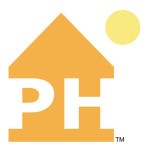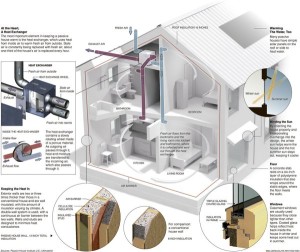I know something new. I know how to design and build homes that are dramatically better than any I’ve ever built. What I know is radically simple. It is systematically measurable and therefore proven. It works.
What I know is how to design and build using the Passive House method. The Passive House Standard is the most rigorous building energy standard in the world. It was developed and proven in Germany and is being embraced internationally (there are 20,000 Passive Houses in Europe). It is now available in the US. Consultants, projects or building components that have obtained the right to carry the logo have committed themselves to design excellence and the Passive House energy performance criteria. I am a Certified Passive House Consultant, one of 200 in the US and the first in the state of CT to provide this service.
WHAT’S SO GREAT? First of all, Passive Houses provides incredible year round comfort. Their built in ability to maintain healthy and comfortable room climates means that temperature, humidity levels, and the inside temperature of exterior surfaces stay within very close margins. The result is a consistent indoor climate few of us have ever experienced. A constant fresh air supply exchanges inside air with tempered and filtered outside air. Occupants are less likely to suffer from allergies and asthma. Filters in the ventilation equipment help reduce pollen and environmental pollutants from the outside air. Beneficial natural daylight is a result of the windows that provide solar gain.
HOW DOES IT WORK? Just like a good investment strategy, the Passive House method assures that a building takes the greatest advantage of available “gains” while minimizing energy “losses”. The resulting “energy balance” provides a building with exceptional comfort and health, simplified operation, and dramatically lower operating costs. Here are the core strategies that, when integrated knowledgeably and measured carefully, assure the standard can be met.
AIR TIGHT CONSTRUCTION To become certified as a Passive House, a stringent air tightness standard must be achieved. Testing is done throughout the construction process to assure that the standard can and will be met. This demands attention to detail in design and throughout construction that few currently practice.
SUPER INSULATION Comprehensive climate data based on the building’s location informs the design of each building component and the amount of insulation each requires to assure the building can maintain comfort with very low energy use. There is no single prescription for the amount of this insulation. Each project responds to the conditions of its site and proposed design.
ELIMINATION OF THERMAL BRIDGES Think of a metal spoon in a bowl of hot soup. Hot to the touch. This is the process of heat conduction. The more successful we are at insulating and air sealing, the more significant every piece of our building that might act like that spoon becomes, conducting heat as energy from inside to out. This effect is called a thermal bridge and a Passive House seeks to locate and eliminate them as the building is designed.
HIGH PERFORMANCE WINDOWS & DOORS Features of each window and door, based on their size and location, are optimized to assure that their energy gains exceed losses. They are thought of as part of the system we usually ascribe to a mechanical system – delivering measurable BTU’s of energy that will heat the building. Achieving this requires the very best windows and doors available, with insulated frames, triple panes of specially selected glass, air tight seals, and design placement that carefully balances summer shading and full winter exposure.
BALANCED VENTILATION WITH HEAT RECOVERY We have always depended on the leakiness of our houses to provide the fresh air we depend on for health. As we insulated and tightened up our homes we made this already unpredictable system potentially harmful. What we need is a consistent and dependable source of clean fresh air that does not steal energy from the house as it is ventilated. This is the system that is central to the success of our air-tight Passive House. A constant source of clean fresh air is cycled through the house at a carefully controlled rate. As the air exits, the heat that would otherwise leave with it is “recovered”. In every way possible, a Passive House is miserly with every drop of precious energy it so conscientiously captures.
OPTIMIZE PASSIVE SOLAR & INTERNAL GAINS With buildings this efficient, the heat generated by people, lighting, and appliances make a real contribution, and these “internal gains” are factored into the design. On an exceptionally cold winter night, just have a party to heat the house! The building is designed and oriented on its site to capture as much available solar energy as possible, especially through windows. While this can also include solar hot water systems, it does not include photovoltaic systems for electricity in the certified building model. The goal is to produce a building that can operate on very little energy, independent of the source. Once achieved, smaller less expensive PV systems are a natural fit.
SMALLER SIMPLER HEATING The small amount of energy needed to provide heat on the coldest days can be provided by the equivalent of a blow dryer! By dramatically increasing the energy efficiency of the building, the mechanical system can be radically downsized. The cost savings are invested in more insulation and better windows and doors. This efficiency “sweet spot” is the basis for the Passive House performance standard and the key to its financial feasibility.
RELIABLE MODELING At the heart of the Passive House design process is the modeling program I have been trained to use. The Passive House Planning Package (PHPP) allows the designer to methodically determine every element of the building design that will effect its performance and assure that certification can be achieved. With the attendant quality control, testing, and site supervision during construction that the consultant provides the building is measured according to the criteria established in PHPP during design and ultimately achieves the Certified Passive House™ designation.
LIMITS ON PRIMARY ENERGY To complete the profile of low energy use the Passive House model measures the entire energy demand of the building, including the energy required to provide hot water, operate lights, appliances, mechanical equipment, and pumps. Certification requires that the measurement of that energy include it’s source or “primary” energy, the amount adjusted to account for the energy that is lost in the generation, transmission, and distribution of the energy. Grid supplied electricity is notoriously inefficient in this regard with approximately one unit delivered for every three generated.
NOT LIMITED TO NEW HOMES The Passive House Standard can be applied to existing buildings as well as new, though the challenges dealing with existing conditions can make this more difficult to achieve than the opportunity the designer has starting from scratch.
NO STYLE LIMITS There is nothing about the method that dictates a single Passive House style. The ethic invites consideration of modest size, and performance is achieved best by simpler forms and good orientation and exposure to the sun. Working within these constraints, it is up to the designer to create an exciting and inspiring building. The top two winners of the 2009 Solar Decathalon held biannually in Washington were Passive Houses.
TAKING RESPONSIBILITY A Certified Passive House™ is a delibrate response to the challenges of climate change and carbon reduction. By using dramatically less energy these are buildings that are truly “future friendly”. Their benefits represent a significant redefinition of comfort and satisfaction. This is the future.
Click on this set of documents to view or print a PDF about Passive House, the Future Friendly Home, Better Remodeling, and Actions you can take and we can guide you in for your own home.
 If you’d like to inquire about Passive House and Wolfworks design, construction, and consulting services please contact Jamie Wolf. Certified Passive House™ and the related Logo is a certification mark owned by the Passive House Institute US | PHIUS and is used by permission.
If you’d like to inquire about Passive House and Wolfworks design, construction, and consulting services please contact Jamie Wolf. Certified Passive House™ and the related Logo is a certification mark owned by the Passive House Institute US | PHIUS and is used by permission.


